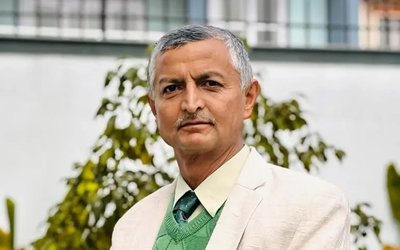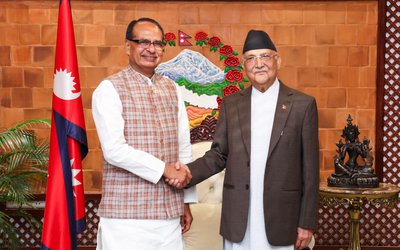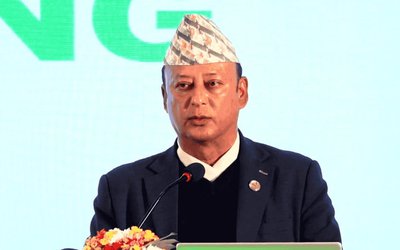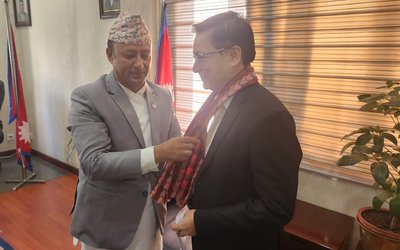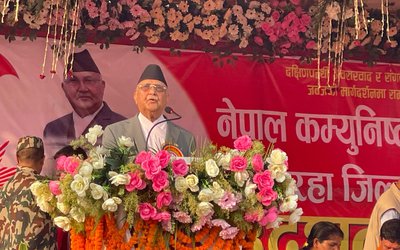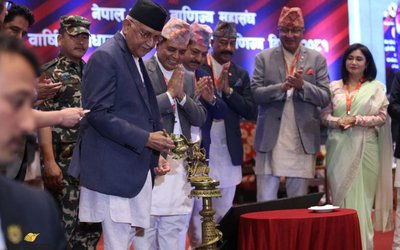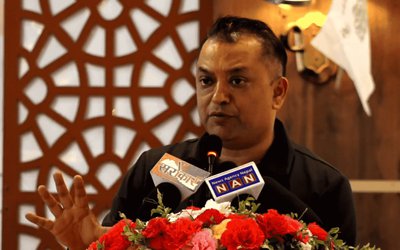
MingmaTamang ofGarlang Village Development Committee of Rasuwa is uncertain when he will get the relief fund to construct his permanent house. As the winter has already deepened, withthe temperaturesometimes going below zero, hundreds of people like Mingma are worried about the winter storm and snowfall.
A large number of earthquake victims living in the temporary shelters in the foothills of the Himalayas have similar stories to share.As they had feared,a major storm and rain brought the snow in the northern parts of Gorkha and Rasuwa creating a panic across the region on January 8.
As the situation is getting from bad to worse, Nepal government has launched a reconstruction drive. President Bidya Devi Bhandariand prime minister KP Sharma Oli launched the national reconstruction campaign by inaugurating Ranipokhari reconstruction project and Bungmati area reconstructionin Karyabinayak municipality.
As the drive was launched almost after eight months, it is still uncertain when it will take a momentum given the country’s overall political situation and lackluster performance of the government.
Although the government has announced it willrelease the first installment or 25 per cent of the relief package, an amount worth Rs 200,000 as announced by the government earlier for the earthquake victims who had lost their homes during the devastating earthquakes of April and May, the process is yet to take pace.
The government plans to release the relief amount to the victims in four installments 25 per cent, 30 per cent, 35 per cent and 10 per cent. Along with the government’s announcement, the victims will get Rs 50,000 to begin construction of their homes.
According to the plan, the government will arrange for further subsidized loan of up to Rs 300,000 in collective guarantee for the families whose houses were fully destroyed by the earthquake.
The first installment of the relief, which will be released at the earliest, will help provide improved shelters for the victims in the hills and high hills, who are still living in tents and transitional shelters made of corrugated sheets, said finance minister Bishnu Paudel.
Humanitarian Crisis
As the government is charting the way to reach help, a humanitarian crisis is looming large as the earthquake victims living in the far remote areas of Nepal are facing the crisis.
According to UNICEF, more than 200,000 families affected by the tremors are still living in temporary shelters, at an altitude above 1,500 meters (4,920 feet) where harsh winter conditions will continue through February.
As theMadhesi groups, who have blocked key border points with India, aid agencies say the shortages have disrupted the efforts to send essential relief items, such as blankets and clothings, to earthquake survivors in mountainous areas.
As the situation is getting from bad to worse, the government has distributed 10,000.00 (US$100) to each family through the local VDCs to purchase warm clothes from second week of January.
According to District Administration Office of Rasuwa, the temperature will continue to decline till the end of February. “The victims can still buy warm clothes from the money given to them,” said a senior officer of Rasuwa District Administrative Office.
However, the people are very much frustrated. “Nothing is moving here. All of us are living in our temporary sheds and we don’t know what to do if the snowfall becomes heavier,” said Tamang.“We are receiving foods and cloths from some INGOs and NGOs. That's it.”
The earthquake which hit this district eight months ago is now gradually fading from the priorities of international media.However, its aftermathis still wreaking havoc on the poor and developing villages all over the country.
Rasuwa’s experiences have shown that natural disasters like earthquake come and go, but it will take years for the victims to recover, rebuild and re-stabilize. Although almost eight months have already passed since the great earthquake destroyed almost all villages of 14 districts of Nepal, affecting over 8 million population, the recovery process seemsto be far away given the political disaster the country is facing.
Although it is business as usual in Kathmandu, people in the earthquake prone areas are without new buildings asthey repair or rebuildtheir old structures. In many villages like those ofRasuwa, rebuilding has not even begun due to the lack of access to these regions, so thousands are living under 'temporary' conditions.
NGOs Effectiveness
Although the various organizationsare involved in the process of recovery, the small NGOs and INGOs are more effective when it comes to distributing the resources to the needy victims. From Gorkha to Rasuwa to Sindhupalchwok, what one gets to see is victims displaying relief packages distributed by the international agencies.
In Rashuwagadhi, international donor agencies have come up with the support programs in the process of building temporary houses to the victims. The District Administration Office has been playing a coordinative role effectively among the various NGOs, NGOs and government agencies.
Similarly, the presence of institutions of the local bodies has also played an important role to carry out the distribution activities.
WFP’s Concern
As the situation is getting worse, the WFP warns of extreme hardship which expected to worsen as food prices soar.
Major disruptions in food and fuel imports acrossNepal's southern border with India have severely affected supplies and caused a worrying increase in food prices, says the United Nations World Food Program (WFP).
With Nepal heavily dependent on imports, especially from India, severe shortages are now being felt in local markets. The cost of some basic food staples, such as cooking oil, rice, lentils, sugar and salthave soared in recent weeks as supplies dwindle.
“If trade remains restricted and food prices continue to rise, a serious humanitarian crisis will be hard to avoid,” said David Kaatrud, WFP Regional Director for Asia and the Pacific. “People are struggling to feed their families as the cost of food rises beyond their grasp. Coming so soon after the recent earthquake, this crisis could severely test people’s ability to cope, and may lead to an increase in malnutrition.”
According to a press release issued by WFP, on average, the prices of lentils, pulses and cooking oil have increased by more than 30 percent since August and more than 50 percent since last year. In remote areas, including parts of the country worst hit by the 25 April earthquake and aftershocks, the price of food commodities has increased even further, doubling in some cases. For example, in Gorkha, a community close to the earthquake epicenter, a 25 kg sack of rice now costs 5,000 Nepali Rupees (US$46.80) – up from 2,500 Rupees (US$23.40) before the blockade. The price of cooking oil and sugar has also doubled in the town.
At the same time, the price of fuel has sky rocketed across the country. The cost of refilling a cylinder of cooking gas has increased from 1,500 Nepali rupees (US$14.00) before the blockade to between 8,000 and 11,000 rupees (US$75 and US$102) today, an increase of as much as 630 percent.
“WFP urges all sides to once again allow the free flow of food items across the border to ensure that Nepalis, especially those who struggle on a day-to-day basis to feed their families, are not the ones who bear the burden of this protracted political stand-off,” said Kaatrud.
As the shortage of fuel continues, there have been severe delays in WFP efforts to provide food assistance to more than 224,000 earthquake-affected people. WFP has only been able to deliver one-third of food supplies earmarked for distribution by the end of the year. The delivery of non-food items, such as medicine and shelter material for winter, has also been severely affected by the dispute.
As the government has announced a major campaign to launch the reconstruction, a study made with the support from international organizations predicted a possible rift. “The arrival of larger scale reconstruction programs may pose challenges for social relations and cohesion. There is a possibility that in some places there will be a breakdown in social relations if concerns regarding damage assessments are not addressed and if perceptions of unfairness in targeted distribution are not taken seriously,” said the report.
Prepared with the support from The Asia Foundation and DFID, Aid and Recovery in Post-Earthquake Nepal, Independent Impacts and Recovery Monitoring Nepal Phase 1 June 2015 has also pointed out the possibility of social rift.
In Garlang Village, the distribution of aid has already divided the society. As relief packages brought to the villages are confined to the roadside, villagers living in the upper sides and remote villages have no access to these at all.
“We are receiving the packages provided by local NGOs and VDC. There are a lot of relief packages for the roadside,” said SonamTamang of Chilime Village Development Committee.
Earthquake Jolts
As the aid package is coming, local people are yet to get the respite from the jolts as the villagers feel small or big jolts daily. “It was like sitting on a swing for almost a month after April 25. Even now, there are jolts less often but people do continue to feel it,” said Tamang.
“Moderate-to-large earthquakes in this region are fairly common,” said the US Geological Survey (USGS) reports. The April 25 7.8 earthquake in Kathmandu, Nepal, and subsequent 7.3 earthquake on May 12, that left almost 9,000 dead is still fresh in the minds of Nepalis and their neighbors.
The border of the Indian and Eurasian plates is home to one of the “most dramatic and visible creations of plate-tectonic forces” in the Himalayas. Stretching almost 2,000 miles between Tibet and India, the Himalayas are evidence of these two plates’ power.
Between 40 and 50 million years ago, the island of India collided into its present location adjacent to the Eurasian plate. The Indian and Eurasian landmasses had similar rock density, so neither plate was subducted under the other, the USGS explains. Thus, the building pressure between the plates was forced to move upwards, forming the highest mountain range in the world.
Typically head-on collisions between plates take place under the Earth’s surface in oceanic trenches as denser crust slides beneath lighter continental crust. But the Indian and Eurasian plates continue to move toward each other, as evidenced by Mount Everest’s 2.4 inch growth each year.
And as the plates continue to move toward one another, pressure from the initial collision persists. “Some of the world’s most destructive earthquakes in history are related to continuing tectonic processes that began some 50 million years ago when the Indian and Eurasian continents first met,” as explained by the USGS.
“We know that such earthquakes are overdue,” Dr. Jean-Philippe Avouac, a geophysicist at the California Institute of Technology, told The Christian Science Monitor in 2011, referencing the 1934 earthquake. “We have a lot of energy that needs to be released at some point.”
GeoHazards International (GHI), a non-profit organization working to reduce earthquake destruction in vulnerable communities throughout the world, argues that preventive earthquake measures are possible and attainable. GHI President Brian Tucker, a prominent geophysicist, studied a number of earthquake-prone cities in 2001.
With the formal launching of the campaign, the reconstruction work in the earthquake affected districts has already begun. However, it is not sure yet how effectively the work takes the shape and picks up its pace.

Keshab Poudel
Poudel is the editor of New Spotlight Magazine.
- PM OLI MEETS PM MODI: No Progress
- Apr 09, 2025
- PM OLI’S THAILAND VISIT: Flip Flop
- Apr 08, 2025
- FM Dr. Deuba’s India Visit: Mission Aborted
- Mar 26, 2025
- AMBASSADOR MAEDA TORU: Warm Regards
- Mar 24, 2025
- PRO-MONARCHY MOVEMENT: Rising Dissatisfaction
- Mar 23, 2025
